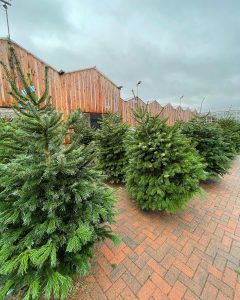
Local charity event returns to kickstart the season of goodwill
October 24, 2022
NIGELLA LAWSON’S YULE LOG
October 24, 2022For some it might seem too early to even start thinking about Christmas, but for others they are already diving headfirst into the festive season. Whether you love it or hate it, Christmas is coming!
Many of us will have climate change in mind when thinking about our seasonal choices, particularly when it comes to choosing our Christmas tree.
But the question is, is it more sustainable to buy a real tree or an artificial one?
Real Christmas Trees
According to the British Christmas Tree Growers Association (BCTGA) around seven million trees are bought each year in the UK. Around 80% are Nordmann Fir and approximately 10-15% are Norway Spruce.
The majority of trees bought in the UK are home grown in purpose-built Christmas tree farms and nurseries. Growing them in the UK reduces the carbon footprint from importation plus you get a much fresher tree! Look out for trees locally grown or produced with a FSC certification.
The most popular size of Christmas Tree is 6-7ft and takes around 10-12 years to grow. During a trees growing stage it not only captures and stores carbon, but is also provides a habitat for wildlife.
Natural trees are biodegradable and can be used for compost. According to The Carbon Trust, when a two-metre tree decomposes it generates a carbon footprint of around 16kg of CO2. If the same sized tree was burned, planted or chipped, its carbon footprint would be over four times less – around 3.5kg of CO2.

Artificial Christmas Trees
Artificial trees are getting more and more popular each year because consumers feel they are being eco-friendly by not cutting down a tree. However, this couldn’t be further from the truth.
Artificial trees are usually produced in factories overseas and shipped to the UK, which increases their carbon footprint.
The majority are made with chemicals, metal and PVC, which are dangerous to the environment and impossible to recycle. The Carbon Trust have said that a two-metre artificial Christmas tree has a carbon footprint of around 40kg of CO2, over 10 times greater than its natural counterpart.
On average, artificial trees are used just four times before they’re thrown on the rubbish heap. Due to the amount of CO2 they give out, they need to be used over 12 times to start making a difference.
Now, Christmas wouldn’t be Christmas without a tree, and it really is all down to personal preference and budget.
Whichever tree you choose we hope it brings you joy over the festive season.
Merry Christmas and happy gardening.




